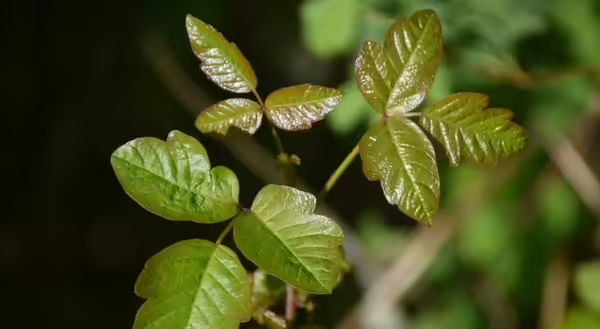
By Jennifer Bass, Extension Master Gardener and Master Naturalist serving Fulton, Mason, Peoria and Tazewell counties
I love my yard with all of the trees, the wilder areas behind my home, and the small prairie plot in the small sunny patch in the front of my house. But, I am frustrated by the amount of poison ivy that is in various places, not only in the woodland and along the woods, but in some beds of flowering plants. I spray and it comes back – seemingly twice as big!
Growing pains
Poison ivy is not a plant that was brought to this country by immigrants; instead, it has been found in fossil beds throughout the United States. It is not picky about where it grows. It can grow into a bush form or vines that grow along the ground and up trees. It's roots can be rhizomes traveling through most soil types or its feathery roots can cling to a tree and climb high into the canopy. Deer enjoy munching its leaves, more than sixty species of birds eat upon its berries and humans scratch from blisters caused by its oils that appear on the skin after rubbing against the plant.
Plants need CO2 in order to grow. Since the beginning of the Industrial Revolution, CO2 levels have been on the rise. Studies have shown that poison ivy especially enjoys CO2, hot days and warm, humid nights, the longer growing season, is thriving, growing faster. It is a plant that is taking advantage of our changing climate. The blisters on our skin caused by the oils, urushiol/rhus dermatitis, are not only annoying but painful. It seems to those of us who are allergic to it, that it is everywhere we go! This aggressive adaptation can be a threat to how quickly it could climb trees in a woodland and the effect it would have on the trees and its toxicity could affect how the rash changes and the treatment by the medical community.
Keep an eye out for it
Make sure you can identify poison ivy. When it is small, many confuse it with the maple seedling or of the three leaves or the boxelder whose leaves are opposite where poison ivy leaves are compound and grow alternately up the stem. What is not always certain is the appearance of the leaflets. Two plants may look very different. Leaf margins may be smooth or serrate, the leaf surface may be glossy or dull, leaves may be lobed or unlobed, and color may be almost any shade of green. A typical shape is that of a mitten, but leaf shape may vary. Older leaves that are large have a different look than small, immature plants. In the spring one may find a small white flower, in the fall the fruit begins to grow as green clusters of berries that change to white. The leaves turn to red in the fall. All parts of the plant, flowers, berries, leaves, and stem are poisonous and when touched by many humans can produce a blistering rash. If the vine is not treated and killed and is on firewood, a person touching the vine in winter may develop the rash. A pet that runs through poison ivy can come home to have you pet it and you can wipe the oils off the pet and spread to your skin.
Avoid a rash
If you come in contact with poison ivy, wash as soon as you can with a soap such a Dawn that repels grease and oil. You can also purchase soaps and oils to help repel and treat poison ivy. And, believe it or not, you can also purchase the poison ivy plant to add to your landscape.
When trying to control the vine, wear long pants and a long-sleeved shirt, gloves and a hat. Cut the vine and treat the stem with a poison for woody plants. Spray the leaves and stem that has been cut. One might want to let it lie until the leaves dry and are brown. When cleaning, rake into a pile and use a shovel to place in a leaf bag for yard debris pickup. If your vine is not dead and you decide to burn the plant, you can gain a reaction from the smoke landing on your clothes. Do not breath the smoke for it can get into your lungs and cause a serious reaction.
One treatment may not eradicate the pesky vine the first year of trying to control it and it may take many times of applying an herbicide. Hopefully one can, with luck, control it in our yards and we will not be scratching a rash and wishing they had dressed better for a walk about.
Photo by James Whitney on Unsplash